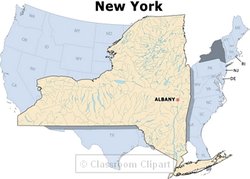Albany, New York
|
|
Albany is the capital of the state of New York in the United States of America. As of the 2000 census, it has a population of 95,658. It is the county seat of Albany County.
The City of Albany lies 145 miles (233 kilometers) north of and slightly east from New York City, and slightly to the south of the juncture of the Mohawk and Hudson Rivers.
| Contents |
History
Template:US City infobox Albany was the second settlement in the 13 original American colonies, after Jamestown, Virginia. Its colonial history began when Englishman Henry Hudson, exploring for the Dutch East India Company on the Half Moon, reached the area in 1609. In 1614 the company constructed Fort Nassau, its first trading post near present-day Albany. In 1624 Fort Orange, the first permanent settlement in the New Netherland colony, was established in the area. The fort was named after the Prince of Orange. Nearby areas were incorporated as the village of Beverwyck in 1652. When the land was taken by the British in 1664, the name was changed to Albany, in honor of the Duke of York and Albany, who later became James VII of Scotland and II of England. The Duke of Albany is a Scottish title given since 1398, generally to a younger son of the Scottish King. The name is derived from Alba; the Gaelic name for Scotland.
Albany received a charter as a city in 1686.
In 1754, representatives of seven of the British North American Colonies met in the Albany Congress. Benjamin Franklin of Pennsylvania presented the Albany Plan of Union, the first formal proposal to unite the colonies.
In 1797 the state capital of New York was moved from Kingston to Albany, about 50 miles up the Hudson River.
- PBS report on the State Capitol (http://www.pbs.org/wgbh/buildingbig/wonder/structure/ny_state_capitol.html)
- New Netherland Project (http://www.nnp.org/)
Geography
Albany is located at 42°39'35" North, 73°46'53" West (42.659829, -73.781339)Template:GR.
According to the United States Census Bureau, the city has a total area of 21.8 mi² (56.6 km²). 21.4 mi² (55.4 km²) of it is land and 0.5 mi² (1.2 km²) of it is water. The total area is 2.15% water.
Demographics
As of the censusTemplate:GR of 2000, there are 95,658 people, 40,709 households, and 18,400 families residing in the city. The population density is 4,474.6/mi² (1,727.5/km².) There are 45,288 housing units at an average density of 2,118.4/mi² (817.9/km².) The racial makeup of the city is 63.12% White, 28.14% Black or African American, 0.31% Native American, 3.26% Asian, 0.04% Pacific Islander, 2.15% from other races, and 2.98% from two or more races. 5.59% of the population are Hispanic or Latino of any race.
There are 40,709 households out of which 22.0% have children under the age of 18 living with them, 25.3% are married couples living together, 16.1% have a female householder with no husband present, and 54.8% are non-families. 41.9% of all households are made up of individuals and 11.5% have someone living alone who is 65 years of age or older. The average household size is 2.11 and the average family size is 2.95.
In the city the population is spread out with 20.0% under the age of 18, 19.3% from 18 to 24, 29.2% from 25 to 44, 18.1% from 45 to 64, and 13.4% who are 65 years of age or older. The median age is 31 years. For every 100 females there are 90.6 males. For every 100 females age 18 and over, there are 86.5 males.
The median income for a household in the city is $30,041, and the median income for a family is $39,932. Males have a median income of $31,535 versus $27,112 for females. The per capita income for the city is $18,281. 21.7% of the population and 16.0% of families are below the poverty line. Out of the total population, 28.8% of those under the age of 18 and 12.5% of those 65 and older are living below the poverty line.
Education
Colleges and universities in Albany include Albany College of Pharmacy (http://www.acp.edu); Albany Law School (http://www.als.edu); Albany Medical College (http://www.amc.edu/academic/college/index.htm); The College of Saint Rose (http://www.strose.edu); Excelsior College; Maria College (http://www.mariacollege.edu); Sage College of Albany (http://www.sage.edu/sca/index.php); and the University at Albany, part of the State University of New York system. Siena College is located two miles north of the downtown area.
Albany Academy for Girls (http://www.albanyacademyforgirls.org), "established in 1814, is the oldest independent day school for girls in the country." (Source (http://www.albanyacademyforgirls.org/admissions/facts_and_figures.htm))
The Albany Academy (http://www.albanyacademy.org), a private school for boys K-12, was founded in 1813. Author Herman Melville was an alumnus. Scientist Joseph Henry made discoveries in electromagnetism while an academy teacher.
Additional facts about Albany
On the southern section of Albany's downtown lies the Empire State Plaza. The Erastus Corning Tower stands 589 feet (180 meters) high, the tallest building in New York State outside New York City. The transmitters for the radio stations WKLI (100.9 FM) and WAJZ (96.3 FM) are based on top of the Corning Tower.
The original native settlement at Albany/Fort Orange was called Penpotawotnot.
Several US Navy ships have been named Albany.
William Alexander, a general in the Revolutionary War, died there in 1783.
Noted industrialist and founder of the New York Central Railroad Erastus Corning called Albany home and served as its mayor from 1834 to 1837. His great-grandson, Erastus Corning II, served as mayor of Albany from 1942 until 1983, one of the longest single mayoral terms of any major city in the United States.
Chester Arthur, 21st U.S. president, is buried in Albany Rural Cemetery in Menands, north of the city.
See also
External links
- City of Albany (http://www.albanyny.org/)
- Movies of the Albany fire department, circa 1901 (http://memory.loc.gov/cgi-bin/query/S?ammem/papr:@FILREQ(@field(TITLE+@od1(Albany,+N+Y+,+fire+department++))+@FIELD(COLLID+workleis)))
- NYCD blue (index) (http://www.december.com/places/nycd/blue.html)
- Albany Times Union (http://www.timesunion.com) Albany's daily newspaper
- Metroland (http://www.metroland.net) "The Alternative Newsweekly of New York's Capital Region"



